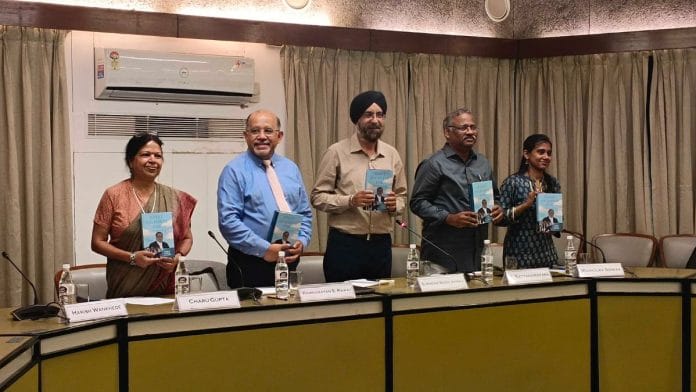New Delhi: Religion, for Dalits, is not always about faith, it’s about social possibilities and transformation, said K Satyanarayana, a professor at the English and Foreign Languages University in Hyderabad. He was speaking at the launch of the book Dalit Journeys for Dignity at the India International Centre, last week.
The book is part of a series on Dalit studies. The first volume, Dalit Studies, edited by Ramnarayan S Rawat and K Satyanarayana, was published in 2016 by Duke University Press. The book’s second volume was published in April 2025 after facing several rejections for two years from Indian and US publishing houses, primarily because the contributing scholars were not widely known personalities, said the professor.
“There were various kinds of rejections because most of these scholars are not visible or known. They have no name. They have no fame,” said Satyanarayana.
Eventually, the volume was published by Permanent Black in the Indian subcontinent and by the State University of New York (SUNY) press for other regions.
The panelists at the launch included Madhulika Sonkar, assistant professor, IIT, Delhi, Harish Wankhede, assistant professor at Jawaharlal Nehru University, Delhi University professor Charu Gupta, Satyanarayana, and Ramnarayan S Rawat, associate professor at University of Delaware.
Dalit Journeys for Dignity: Religion, Freedom, and Caste is a collection of essays that highlight the fight for dignity and equality in India. Edited by Satyanarayana, Rawat, and P Sanal Mohan, the book unveils personal narratives of caste hierarchies and explores the creation of neo-cultural practices.
“The book urges us to re-examine the interests of the mind, and the histories of caste, religion, politics, and literature in shaping modern India,” said Satyanarayana.
A university press in the US rejected the book due to their internal policy, which requires approval from two reviewers. Since the book did not receive it, it was ultimately turned down. Most contributors were young or marginalised scholars without recognition, which many publishers see as a disadvantage.
“Dalit Studies II is a project of knowledge production — knowledge created from the margins, by scholars rooted in those very experiences,” said Satyanarayana. “This volume is not only about resistance; it is about dignity — human dignity even before civic status.”
Journey of conversion
Six essays in the book explore the distinct trajectories of Dalit communities in their search for religious alternatives — Christian conversions in colonial Tamil Nadu, Buddhist renunciations in Maharashtra, and contemporary Dalit-Christian movements in Telangana, Andhra Pradesh and Kerala.
One of the essays is by Chakali Chandra Sekhar, who traces the story of Nanchari, a Mala weaver-trader and community headman of Rayasaleema in southern Andhra Pradesh. He was sent to jail for trying to enter a Hindu temple, after which he converted to Christianity in prison in 1838 in search of dignity. Nanchari’s conversion then started a mass conversion movement amongst local Mala weaver-traders.
“Conversion is not an escape, but a confrontation and a way of asserting self-worth,” said Sonkar, quoting the book.
Three of the essays in the book specifically examine the struggle against the caste system in Hinduism. They include stories of people who struggled and fought for land ownership, sartorial choices, and even their living spaces and jobs.
Anupama, one of the nine authors of the book, talks about Dalit clothing in colonial India. She explains how the clothing served as a manifesto, a way of expressing identity.
“Wearing the clothes of the dead was a symbol of being branded as death itself. So reclaiming attire was a way of reclaiming one’s skin and identity,” said Charu Gupta.
In his essay, Sumeet Mhaskar uncovers how in Mumbai’s mills, caste influences factory work, pushing Dalits into the dirtiest forms of labour.
Another essay by Rawat and Sekhar also focuses on Muslim conversions among Dalit women where the act of conversion is reshaping the discourse of empowerment within deeply patriarchal contexts.
“Conversion to Islam is also offered as a way of stepping outside or moving beyond the caste Hindu framework,” reads a line in the book.
However, conversion does not come without consequences. Many Dalit converts encounter a complex predicament — while they shed the caste identities imposed by Hinduism, they often face new forms of invisibility and denial within the secular or non-Hindu spaces they enter.
“Caste doesn’t disappear with conversion,” said Surinder Jodhka, a professor at JNU who moderated the discussion. “Their struggles for dignity continue in new guises.”
Also read: Umaid Bhawan to CST Mumbai—how foreign architects shaped India’s buildings
A daily struggle
Sonkar shared a story from her classroom at IIT Delhi. One of her students, who comes from a marginalised community, told her, “Every semester, I have to change my rank.”
The student was in the Computer Science (CS) branch which is typically chosen only by top rankers in the JEE Advanced exam. But because he gained admission through reservation, people often questioned whether he truly deserved the seat. Every semester, he felt the need to prove that he had earned his seat.
“What if we had more such texts, more stories like these, in classrooms? What if students could learn about caste not just through numbers and data, but through lived experiences?” said Sonkar.
Gupta, meanwhile, explained the daily struggles faced by Dalits and other marginalised communities — within the community to schools, colleges, and workplaces. She said Dalit stories of struggle have helped other marginalised people to come forward and express themselves. Books like Dalit Journeys for Dignity will further help the marginalised in future.
“Dalits are socially flourishing through conversion, poetry, new rituals, reclaiming names, and love that defies boundaries,” Gupta said.
(Edited by Aamaan Alam Khan)







What a joke. Since when conversion to Islam from Hinduism have give empowerment to women?
If this kind of analysis is done by intellectuals then we are better off without them.